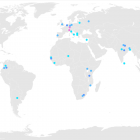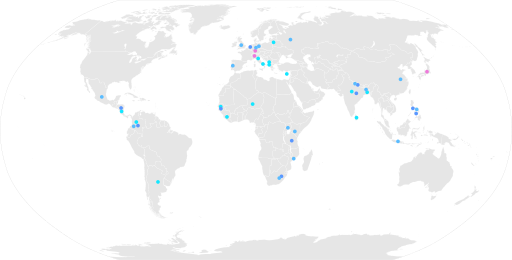In a bit more than a month the State of the Map conference 2019 in Heidelberg will start and since the program is available now – including abstracts – here a bit of analysis of what we can look forward to.
I looked over the talks and workshops in there and made a rough categorization. This is not meant to be exact science of course – there are obviously borderline cases. Lightning talks are not included in this analysis.
- There are about 25 program items from commercial organizations of some kind. Roughly half of these are big, international corporations. Most corporation have only one talk in the program.
- There are about 24 program items from non-commercial organizations of some kind – from universities and public institutions to non-profits and organized community projects. About five of these are from the OSMF (who runs the conference). Apart from the OSMF no single organization seems to account for more than two talks.
- There are about 22 program items i would classify as from individual community members or non-organized community projects.
As usual without being able to look at what spectrum of submissions these were chosen from it is hard to say much about this selection but it seems clear that care was taken to achieve a balance of different types of talks on many different levels. The most obvious bias is for English language – which i would be very much in favor of relaxing as a requirement. But that is just my opinion. Further thoughts on the general concept of SotM you can find in my post from last year.
Recommended talks
From a quick look over the program here a few recommendations on what to me seem to be very promising program points. This is not meant to dismiss any of the other talks as less valuable or interesting – it should be understood as a list of program points that stand out in my eyes, maybe as a suggestion what to visit if you can only see a handful of talks and have no more specific thematic interests.
- Introduction to OSM: How it’s made and how it’s used – while probably not offering a lot of new insights for experienced visitors the concept of this program item promises to be fun and certainly worth visiting.
- Communication and Knowledge Transfer in OSM – although i fear during a 20 minutes time slot this will hardly do more than quickly touch the subject this is a topic of high importance and central to the future success of the project. Hanna will probably provide both a solid summary of the status quo and a valuable perspective on where the deficits and problems are that need to be worked on.
- Mapathon, mapathon, mapathon! – the title could certainly be improved, the main topic here is a critical look at established practices in collective community mapping endeavours (a.k.a. mapathons). Séverin and Nicolas have extensive experience in cross cultural cooperation on mapping in OpenStreetMap and the talk promises to bring this cross cultural dialogue into the conference with participants from different countries contributing their thoughts and experiences directly. This talk is the starting point to a number of program items following up on similar subjects – a second talk directly afterwards and a bilingual discussion session later.
- Is the OSM data model creaking? – critical reflections on the fundamentals of the data model are rare both in OpenStreetMap and in the GIS world. This talk promises something along these lines – a subject of high importance in my eyes. Since the focus of the talk is on a fairly specific use case (cycling maps and routing) there is a chance that it will end up talking about relatively cheap workarounds specific to this use case but it might also take a more fundamental look which would be particularly interesting.
- New processes to agree on tagging suggestions and their interaction with the editing software available on openstreetmap.org – this might serve as a more specific followup to the Communication and Knowledge Transfer talk mentioned above. Roland always provides a sober analytic perspective on things. He also takes the innovative approach here to specifically invite contributions from people who are not at the conference. This way the session seems designed more as a followup to a process of collecting ideas on the subjects via digital channels. Independent of the subject – which is of high interest in itself – this is an interesting and innovative approach for having a discussion, developing and exchanging ideas and connecting remote digital communication with an in-person workshop.
- OSM Vector Tiles in custom coordinate systems – Coordinate system agnostic map rendering is a matter almost completely ignored by the cartographic mainstream in OpenStreetMap. Like with the OSM data model talk this might also turn out to be relatively superficial but there are so many interesting problems related to this topic most of which most map producers are unaware of that this could very likely be interesting for people producing or who want to produce maps in other projections than Mercator.
Scholarships
One other very interesting program item is Scholar Lightning Talks which provides the first publicly available piece of information on the otherwise extremely intransparent SotM scholarship program after the call for application. The list of talks does not necessarily include all OSMF scholars at the conference – there might be others who have a regular talk or give no talk at all. But it lists 10 scholars which is plausible to be the full set or at least nearly the full set of people that receives a scholarship.
So where do the scholars come from? We have:
- Philippines (x2)
- Nepal
- Lesotho
- India
- Nicaragua
- Netherlands
- Gambia
- Tanzania
- Colombia
For comparison – last year we had:
- Germany (x2)
- Portugal
- UK
- Russia
- Mexico
- Colombia
- Uganda
- Kenya
- Lesotho
- Mozambique
- Philippines
- Nepal
- Bangladesh
- Indonesia
- China
And 2017:
- Bangladesh
- Albania (x2)
- Lithuania
- Cyprus/USA
- India
- Argentina
- Italy (x2)
- Senegal
- Niger
- Nicaragua/Costa Rica
- Sri Lanka
- Sierra Leone
- Colombia
Notice something? Well – first of all obviously SotM 2020 is most likely going to take place on the Philippines since the previous two SotMs took place in countries where the previous year there were two scholars from. For more patterns look at the following map showing the distribution of scholars from the years 2017, 2018 and 2019 (in blue the home of the scholars, magenta the conference locations).
As explained previously there is a clear geographic bias in where SotM scholars come from. This can well be illustrated in terms of statistical likelihood to become a scholar. Note this is an overall bias in the whole process – from being attracted and motivated to apply for a scholarship until actual selection. Due to the lack of any public information on where the applicants for scholarships come from (this has been kept secret by the OSMF despite inquiries) there is no way to determine if this bias primarily lies in the selection or already before.
- If you are from Africa your chances to become a SotM scholar is much higher if you are from south of the Sahara (10 of 10 are from there) and significantly higher if you are from a former British colony (7 of 10).
- If you are from the New World your chances are much higher if you are from the larger Central America region between Mexico and Colombia (6 of 7).
- If you are from Asia your chances are much higher if you are from a former Britisch or US colony (10 of 12).
- If you are from Northern Africa, the Middle East or Central Asia your chances are very small (none of a total of 41 scholars comes from one of these Regions).
- Individual countries with a strong preference are: Colombia (3x), Philippines (3x), Albania (2x), Germany (2x), Italy (2x), Nicaragua (2x), Lesotho (2x), India (2x), Nepal (2x), Bangladesh (2x).



Pingback: weeklyOSM 474 | weekly – semanario – hebdo – 週刊 – týdeník – Wochennotiz – 주간
Pingback: [Перевод] Новости из мира OpenStreetMap № 474 (13.08.2019-19.08.2019) | INFOS.BY
Pingback: [Перевод] Новости из мира OpenStreetMap № 474 (13.08.2019-19.08.2019) - Bank News, Банк новости, Седат Игдеджи(Sedat Igdedzhi), Все новости вместе, робот новостей, сборник н